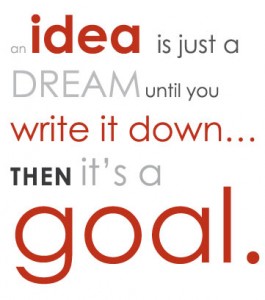student leadership
A Guide to Goal Setting
Be it professional, academic, or personal, effective goal setting is easier said than done. Your goals can only turn into reality, if they were set correctly in the first place. Before you embark on setting your life goals, read through this guide to ensure you’re your goals are set in the right direction.
Determine what your goals should be.
Do this by allowing some time for contemplation, and thinking what is important to you. Brainstorm and list down all the things and targets you would want to achieve and eventually shortlist the most important ones.
Set your goals to be high in quality, not quantity.
Having a list of 20+ goals may not only be overwhelming to look at, but holds a higher chance to demotivate and slack you. To ensure accomplishing them, focus on the most important of your goals, which should ideally be 5-7 in number and be concise enough to be stored in your memory.
Make sure your goal setting is S.M.A.R.T.
That being said, S.M.A.R.T. goals refer to goals that are:
Specific:
To make your goals turn into reality, you need to identify what you exactly need to accomplish and set a course of action accordingly. Be as specific and unambiguous as you can when setting your goals, for example, ‘travel and explore’ may be too wide and vague a goal, but narrowing it down to ‘Travel and explore the historical cities of Europe’ may add some direction and precision to it.
Measurable:
Having a measurable goal is necessary to be able to track your progress and decide on future strategies to move towards it. If you wish to buy your own apartment worth $20,000, a measurable goal would be to save $5000 each year for four years and break it down into monthly savings to enable you to plan your expenses and keep an account of your savings.
Achievable:
Let your goals start with an action verb to make them attainable. Instead of formulating a goal to ‘be more consistent in Math grades’, make it more achievable by rephrasing it as ‘Solve two sample papers each week to obtain better grades in Math’
Realistic:
While an ambitious goal setting should call for getting out of your comfort zone and aiming high, one has to ensure that the goals are sensible and practical. Aiming to reach the top ten employees in your first month at work may prove to be too imaginative, work towards improving your productivity and getting a name under notable achievements for the month instead.
Time-constrained:
While “I will lose 20 pounds” maybe achievable and measurable, it does not provide a time limit to achieve. Planning to lose 20 pounds in four months makes the goal time bound and dividable into smaller monthly goals, hence making it more specific and reachable.
Write them down and review them frequently.
Once you have your goals written down, you have half the action plan to achieve them. Writing your goals down reassures you of your intention to make them happen and sets things in motion. A written goal also serves as an effective reminder and progress tracker. Review your goals regularly and evaluate your current progress towards achieving it, and determine your next steps to move towards them. It depends on your individual preference to review them daily, weekly or monthly, but make sure to keep yourself inspired, motivated and well-reminded of your objectives.
Avoid going public with your goals.
Remember they are your goals and should remain personal to you. No one else can associate the same feelings of enthusiasm, dedication and commitment to your goals. Unless you think that sharing them with a certain person, an expert, mentor, business partner or group leader, for example, may help you achieve your goals, avoid sharing them with others as it may make them less likely to materialize.
How to Make Your Leadership Games Teach & Energize
A well-chosen selection of fun leadership games, team-building exercises, and icebreakers that get high school leaders up and moving is an invaluable part of any activity director’s arsenal. The right activity can break up the monotony of your class, work as a topic lead-in for your important leadership lessons, and create meaningful bonds among your student government. However, even the best group games depend on the skill of the game leader.
After 17 years, being involved with youth leadership conferences and classes, I’ve discovered what it takes to make a group game work and am excited to pass it on to you. Just use these simple secrets and you’ll be leading games like a pro!
Safety First!!
Keep your games safe! Just since it sounded fun on the internet, doesn’t mean that it’s the right game for your group. Use your common sense and be safety minded. NEVER introduce an icebreaker game that will make others uncomfortable – physically or mentally.
Play With A Purpose
Get to know me games are a great way to ease students through the discomfort that comes with getting to know strangers. However, don’t miss the opportunity to include valuable lessons into your fun. Pick games that purposefully demonstrate communication skills, team-building, empathy, and other student leadership qualities instead of letting those teachable moments pass you by.
Make Your Explanations Clear
Keep your games simple! Every rule you add is just one more obstacle between you and the success of your games. When giving the instructions, don’t assume they understand you. If possible, write them down for clarity, give an example, or bring a couple of students up to do a demonstration.
 Keep Things Moving
Keep Things Moving
Don’t spend too much time on any one game. Icebreakers that take longer than 15-minutes quickly lose their momentum! Advancing through two or three shorter high-action games related to your teaching topic is best. Pay attention to the participants to make sure that they’re having fun. If your game just isn’t working – move on to another.
Involve Everyone
Don’t force people to participate. However, both students and adults should be encouraged to join in the activities, or at least show respect by paying attention. Advisors and student helpers socializing or texting during your session will quickly kill the team-building energy you’re trying to create. Casually enlist your inattentive lurkers to partner up in for next game expressing that you could really use their help.
Follow Up With Discussion
At the end of your games, gather your student leaders for a discussion on the leadership skills that were just demonstrated through their play. Don’t expect your students to get ‘the lesson’ just by playing the game without an explanation as to how it relates to your topic. Have questions ready to act as a guide, but let your student leaders take the lead and talk about their “Aha!” moments.
• • • •
That’s it! Over the next several days I will be adding an online collection of my favorite quick yet effective leadership games complete with directions and follow-up discussion questions. Look for them under the blog category Play With Purpose. Let me know if you like ’em and I’ll keep adding. If you have any favorite energizer that you think readers would enjoy, additional discussion questions, or requests, please send them along to me.
Oh one last tip: Remember, they’re just games… so have fun!
How To Set Goals | Goal Setting Fundamentals
“A leader is one who knows the way, goes the way, and shows the way.”
— John C. Maxwell
⇒ Leaders Set Goals
Do you consider yourself a leader?
Sometimes we associate leaders with high-profile, powerful positions.
• The CEO of a Company.
• The Principal of a School.
• The President of the United States
And yes, these people are leaders. But you don’t have to be rich, famous, or powerful to be a leader. You just need to be a person who leads.
Leaders are needed in all areas of life — in families, amongst friends, on teams, in the workplace, and on campus.
They’re the ones that open doors for others to follow and set the standards by which we live.
Leaders can possess a variety of different characteristics and personality traits. They might be driven, intelligent, creative, hard-working, charismatic, or even domineering. But the similarity that one can find amongst almost every leader… THEY HAVE GOALS!
“You can practice shooting eight hours a day, but if your technique is wrong, then all you become is very good at shooting the wrong way. Get the fundamentals down and the level of everything you do will rise.”
—Michael Jordan
⇒ Fundamentals of Effective Goal Setting
In goal setting, technique is everything!
When I hear people explain that they are having trouble with accomplishing their goals, it is usually because they started off wrong from the beginning. They had bad goals. I don’t mean the things they wanted were bad. It’s just that they didn’t set their goals up for success.
A goal is more likely to be accomplished if it’s designed with these qualities in mind:
1. YOUR GOAL MUST BE POSITIVE
2. YOUR GOAL MUST BE SPECIFIC
3. YOUR GOAL MUST BE REACHABLE
4. YOUR GOAL MUST BE PERSONAL
If your goal doesn’t satisfy these four requirements, you might run into some trouble along the way. Over the next few posts, we’ll take a closer look at these characteristics that differentiate a good goal from a bad goal.
NEXT UP: How To Set Goals Quality #1: Make Your Goal Positive
Do you have any favorite goal-setting lessons, quotes, games, or activities that you use to teach goal-setting? Maybe you know a great tip to help eager goal-setters reach their goals faster? Leave your comments below!
I look forward to a great goal-setting discussion!
Leadership Game | Words of Wisdom Student Leadership Quote Game
Leadership Game | Words of Wisdom Student Leadership Quote Game
[divider height=”30″ line=”1″]
Description
Students walk around the room reading a series of posters, each which display a different quote highlighting a possible quality of a leader (quotes provided). Every student chooses a quote to stand by that illustrates the concept of leadership closest to their own beliefs. A discussion of leadership qualities proceeds from there.
Purpose
This is a great lead-in to discussing qualities of a leader with your students. The students begin by reading and thinking about leadership concepts and philosophies as spoken by some of our world’s greatest leaders. They continue with a discussion on the various qualities of leaders and identify their own leadership beliefs and styles.
Materials Required
- Scotch Tape
- 15-20 signs with leadership quotes – 20 Awesome Leadership Quotes PDF
- Optional but recommended: A whiteboard to right down leadership quality answers
Time to Play
30-45 minutes
[divider height=”30″ line=”1″]
INSTRUCTIONS
The set-up:
-
Print out 20 Awesome Leadership Quotes PDF .
- Depending on the size of your group, pick out 10-20 quotes that you would like to use for your game.
- Tape the quotes on the walls in no particular order. Several students may gather around certain quotes, so leave plenty of room between each poster.
The game:
- Ask the participants to leave their chairs and walk around the room reading each of the quotes.
- Instruct them to choose and stand by one quote that best relates to their own view on what makes a good leader.
- When everyone has selected a quote, have them discuss among others who chose the same quote why that quote is important to them. Note: the number of participants gathered around each quote will likely vary.
- Encourage the group to share their own leadership experiences that illustrate their quote.
- Each quote group will then select a member who will share the groups view and give examples.
- Have each group’s spokesperson explain to the rest of the room the reason behind their choice using some of the examples provided by the group. Talk about the importance of the identified leadership skill.
- Proceed moving from quote to quote allowing each group to answer and discuss their leadership beliefs as it relates to their quote.
[divider height=”30″ line=”1″]
DISCUSSION IDEAS
If possible, write your key ideas on the white board. These can launch further discussion questions or a lead-in to additional leadership content.
1. Ask the students to identify and discuss each of the core leadership concepts illustrated within each quote. Lead a discussion on which concepts are important to leadership. Encourage your student leaders to use specific and personal examples.
2. Discuss with your class the importance of each of these leadership qualities as they apply to student leadership and leading a campus. Ask “Are there some qualities more important than others?” “Why?”
3. Illustrate common or hypothetical challenges that your student leaders might face as they fulfill their role as a leader on campus. Have your students identify and discuss which leadership qualities might be useful to handle each situation.
4. Ask “What are the benefits of working as a leadership team as we proceed to lead our campus?” “Is a combination of student leaders and student council officers with different strengths more beneficial than one leader in complete control of the leadership vision?”
5. With your leadership qualities identified and written on the whiteboard, ask your group to call out the names of leaders both admired and hated that exhibit some of these leadership qualities and write them on the board. You will hear names of both popular leaders like Martin Luther King and Mahatma Gandhi as well as some leaders not so admired. Discuss how these leaders were effective leaders no matter if we agree with their leadership goals and direction. For example, Adolf Hitler may have been an evil man but he certainly had strong belief in his vision, his ability to move a nation, as well as other leadership qualities.
6. The 20 Leadership Quotes PDF includes the quote: “Leadership is something I was born with.” If you choose to use this quote in your game it can be a great lead-in to the sometimes controversial discussion whether leaders or born or made.
[divider height=”30″ line=”1″]
COMMENTS
- Ideas stick better when accompanied by a personal example. Your students will gain greater retention of your discussion points when they accompany their basic answers with an example or descriptive story, hypothetical or real, that involves how they have or will use their leadership skills in a personal away. Encourage this sort of response and ask follow up questions if you must.
- Use this as a anti-bullying game! Switch out the leadership quotes for quotes relating to respect, tolerance, and other key words that can lead to anti-bullying discussion.
- A better formatted version of leadership quotes PDF coming soon!
- New at leading group games? Check out this article that explains the simple secrets that will leave you leading games like a pro! Playing With A Purpose: Simple Secrets To Leadership Games That teach And Inspire
• • • •
Do you have a great follow up discussion question or idea that would add to this activity? Do you know a variation or game twist not included here? Or perhaps you know a different game or activity that leadership teachers and trainers could use as a starting point to discuss leadership qualities and leadership styles with their students. Let us know! We want to hear from you!
Leadership Game | “Yes! And…” | A Fun Improv Game With A Leadership Lesson!
Leadership Game | “Yes! And…” | A Fun Improv Game With A Leadership Lesson!
Description
In college, I took Improvisation for Actors. It was a class where through interactive games, you practice acting, problem solving, or just reacting in the moment and in response to the stimulus of one’s immediate environment and inner feelings. One of my favorites that semester was the game: “Yes! And…” It’s purpose, I was told, was to ingrain the actor in me with a positive mindset – a skill necessary not just for acting and improv, but also for anyone who wishes to be an effective leader.
Throughout the game, volunteers come to the front one pair at a time and converse with each other in front of the group. However, the players must always beginning every response with “Yes and…” then continue the sentence in a positive manner following the lead of your partner. It’s not only a fun way to play and bond with your team, it also leads in to a great leadership discussion.
Purpose
Quick and positive thinking are highly valued in improvisation because when a player adopts a negative mindset (using “But” or “No”) a scene will not advance optimally and naturally as is the intent. However, these skills are also necessary for anyone who wishes to be an effective leader. Leaders often need to exhibit a forward moving attitude even when the unexpected occurs and adapt to new directions and ideas that might be different from their own personal vision or beliefs. This great game is great for practicing positive thinking and lots of fun too! It also teaches you how to always have something to say.
Group Size
15-25 participants. Smaller groups work best but I’ve used this well in groups of 250+.
Only 2 volunteers play at a time in front of the group.
Materials Required
No materials required.
optional – use a dry erase board for writing participant’s key point answers and “a-ha!” moments during discussion.
Time Required
10-15 minutes
[divider height=”30″ line=”1″]
INSTRUCTIONS
Step 1:. You will explain the rules of “Yes! And…” giving a sample dialog with yourself, or if possible, enlist the aid of a student helper who has played before or who you can teach the game prior to the session
Tell your group:
In this game partners will have a discussion between themselves in which both must listen to what their partner says, then respond to whatever it was they said beginning your sentence with the words “Yes! And…” then complete the sentence in a positive upbeat manner that will not only support but expand the original concept bringing it to the next level.
For example
Player A says: “This classroom is sure filled with a bunch of desks!”
Player B responds: “Yes! And I heard that at last count there was more that a million!”
Player A says: “Yes! And if we stacked them all one on top of the other they would reach the moon!”
Player B responds: “Yes! And that would sure be a great way to get to the moon rather that a rocket.”
Player A responds:“Yes! And I’ve always wanted to go to the moon since I’ve heard its made of green cheese!”
Play B responds: “Yes! And I hear that every third Friday is cheese tasting night up there!”
Explain: Players will continue this conversation until I shout “Cut!”
Step 2: Pick two volunteers who want to give it a go!
Step 3: Either allow the first speaker to begin with a random statement or involve your group letting them call out a topic for the players to follow.
Step 4: Let them create their dialogue allowing it to grow more and more outrageous. When the pair reaches a big laugh shout “And… Cut!” in your favorite Hollywood director voice. If they don’t reach a laugh cut them after several responses and send them off with applause as well.
Step 5: Always, encourage players to “Thank your partner for playing with you!” before they part.
Step 6: Allow every pair of volunteers to return back to the group with a round of applause.
Step 7: Bring up two more volunteers and do it again and again till everyone who wants to has had a turn before turning the activity to discussion.
[divider height=”30″ line=”1″]
DISCUSSION IDEAS
- Talk about the positive thinking skill as it related to the “Yes and…” game they just played and ask your group, “In what way is this an important skill for an actor or someone who plays these improvisation games?” Discuss with your group how this skill of moving forward with a positive attitude can also work to the benefit of their leadership team and more so, as a leader on their campus.
- Ask the group, “How did the game make you feel with the pressure from having to quickly answer on a strangely evolving topic.” And, “How do you feel when someone presents answers or goes in a different direction all together from what you specifically had in mind as the leader?” “How do you handle it?” “How should a leader handle these situations?”
- Explain that this game is often played by improvisation groups to build flexibility and quick thinking – two highly desired skills by any actor. Ask “What other skills make for a good improv players?” “Why?” If possible, write down answers the skills on the dry erase board for easily referral for the next question.
- As a continuation to #3, ask “Which of these skills could also be a skill important to you as a leader?” “Why?” Encourage them to give examples and possible scenarios.
[divider height=”30″ line=”1″]
COMMENTS
- Try leave on a good note. When you shout “and cut”, do it at the end of a “Yes and…” comment that gets a good laugh from the group.
- Remember, like many leadership and team-building games, this in not just a quick game in route to an object lesson. This game actually is great practice in developing these invaluable leadership skills. Incorporate this and other leadership skill building games into your leadership or student council class on a weekly basis.
- Ideas stick better when accompanied by a personal example. Your students will gain greater retention of your discussion points when they accompany their basic answers with an example or descriptive story, hypothetical or real, that involves how they have or will use their leadership skills in a personal away. Encourage this sort of response and ask follow up questions if you must.
- New at leading group games? Check out this article that explains the simple secrets that will leave you leading games like a pro! Playing With A Purpose: Simple Secrets To Leadership Games That Teach And Inspire
• • • •








